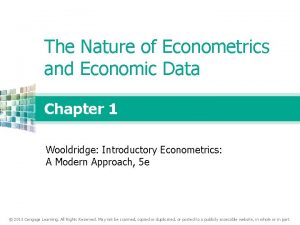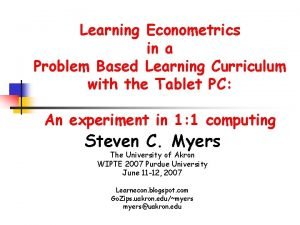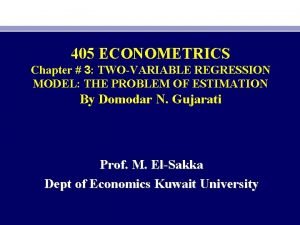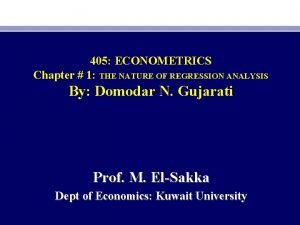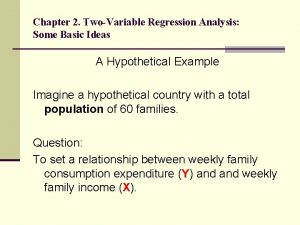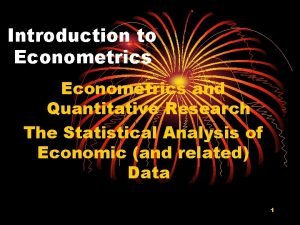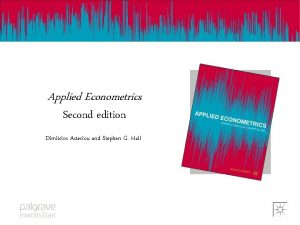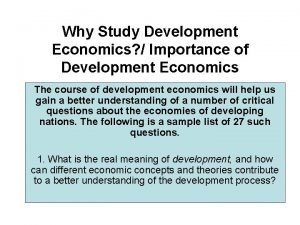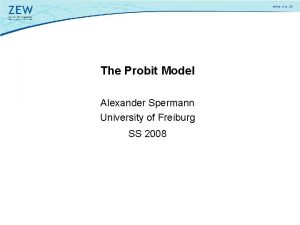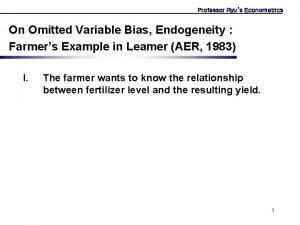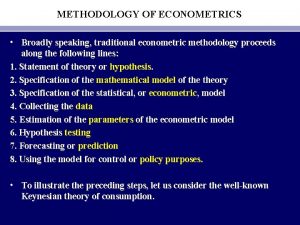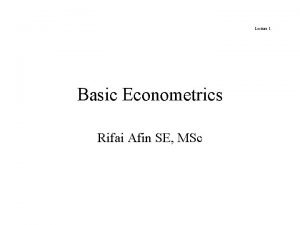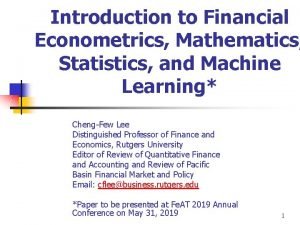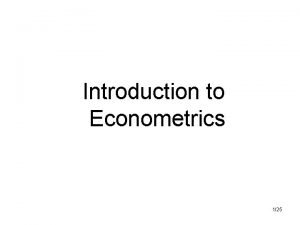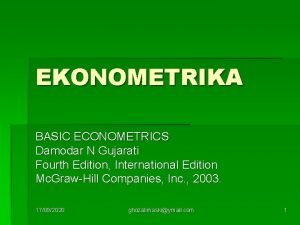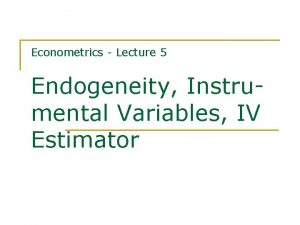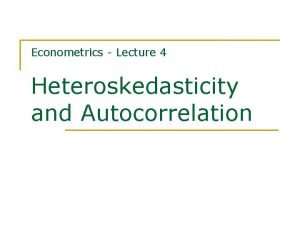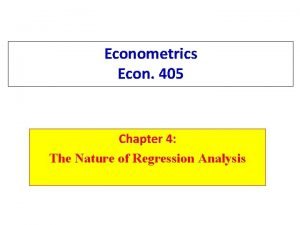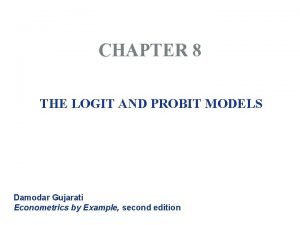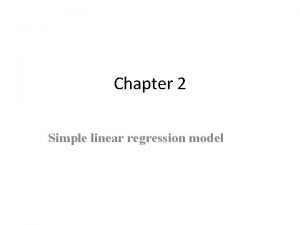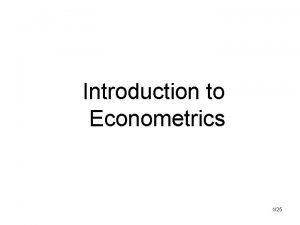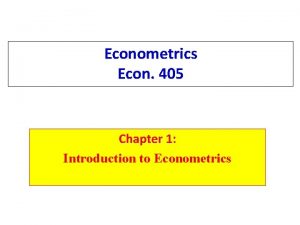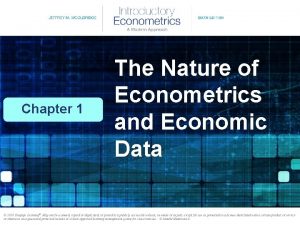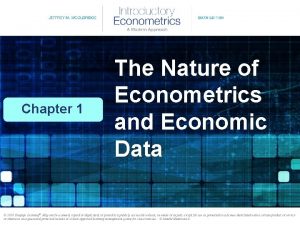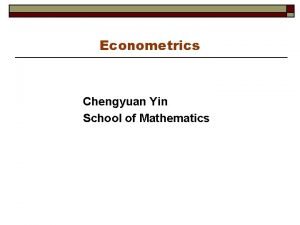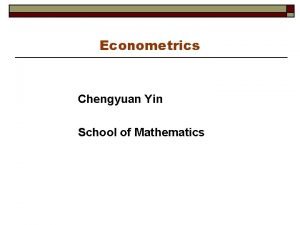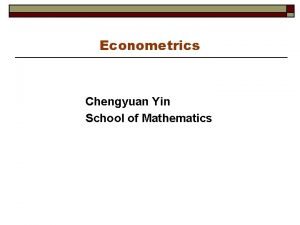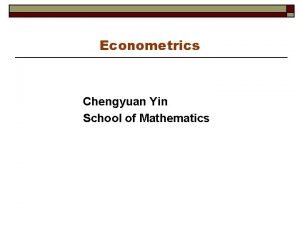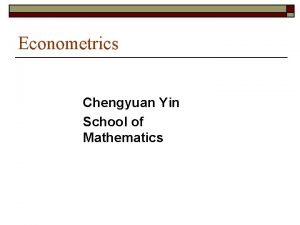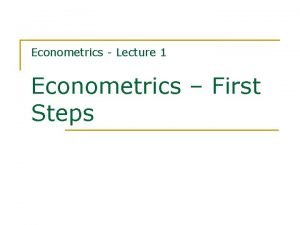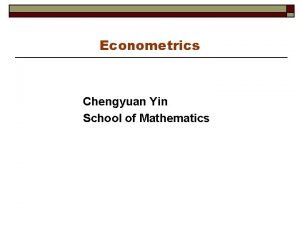Chapter 1 The Nature of Econometrics and Economic






























- Slides: 30

Chapter 1 The Nature of Econometrics and Economic Data Modified Version by Woraphon Yamaka © 2016 Cengage Learning®. May not be scanned, copied or duplicated, or posted to a publicly accessible website, in whole or in part, except for use as permitted in a license distributed with a certain product or service or otherwise on a password-protected website or school-approved learning management system for classroom use. © kentoh/Shutterstock.

What is econometrics? Statistic Test the Hypothesis and Robustness Problem statement Economic Mathematic Compute and derive the unknown parameters © 2016 Cengage Learning®. May not be scanned, copied or duplicated, or posted to a publicly accessible website, in whole or in part, except for use as permitted in a license distributed with a certain product or service or otherwise on a password-protected website or school-approved learning management system for classroom use.

Econometric tree (Basic Approaches) Econometric Estimator Least Squares Model Data Robustness Test Linear Time Series T-test Maximum Likelihood Non-linear Crosssection F-test Bayesian System Equations Entropy Panel Autocorrelation Heteroskedasticity Multicollinear Learning®. © 2016 Cengage May not be scanned, copied or duplicated, or posted to a publicly accessible website, in whole or in part, except for use as permitted in a license distributed with a certain product or service or otherwise on a password-protected website or school-approved learning management system for classroom use.

What are Econometricians try to do? • They try to do four things: • First : Forecasting and prediction • Second: Causal effects ( the effect of something to another thing) • Third: Testing (Robustness check) • Fourth: Use the result to evaluate and implement government and business policies To do this • Econometricians use of statistical methods to analyze economic data • Econometricians typically analyze nonexperimental data © 2016 Cengage Learning®. May not be scanned, copied or duplicated, or posted to a publicly accessible website, in whole or in part, except for use as permitted in a license distributed with a certain product or service or otherwise on a password-protected website or school-approved learning management system for classroom use.

Steps in econometric analysis States the economic problem and equation problem Collect and Analyze the data Select the model Result and policy implementation Select the estimator Select the test © 2016 Cengage Learning®. May not be scanned, copied or duplicated, or posted to a publicly accessible website, in whole or in part, except for use as permitted in a license distributed with a certain product or service or otherwise on a password-protected website or school-approved learning management system for classroom use. 5

States the economic problems Maybe micro- or macro models • Causal effect problems • Often use optimizing behaviour, equilibrium modeling, … • Establish relationships between economic variables • Examples: demand equations, pricing equations, … • Forecasting problems • Forcasting GDP, FDI, . . © 2016 Cengage Learning®. May not be scanned, copied or duplicated, or posted to a publicly accessible website, in whole or in part, except for use as permitted in a license distributed with a certain product or service or otherwise on a password-protected website or school-approved learning management system for classroom use. 6

Collect the data ● Econometric analysis requires data ● Different kinds of economic data sets • Cross-sectional data • Time series data • Pooled cross sections • Panel/Longitudinal data ● Analze the data to find the best fit method • Use of inappropriate methods may lead to misleading results © 2016 Cengage Learning®. May not be scanned, copied or duplicated, or posted to a publicly accessible website, in whole or in part, except for use as permitted in a license distributed with a certain product or service or otherwise on a password-protected website or school-approved learning management system for classroom use. 7

The Nature of Econometrics and Economic Data 1) Cross-sectional data sets • Sample of individuals, households, firms, cities, states, countries, or other units of interest at a given point of time/in a given period • Cross-sectional observations are more or less independent • For example, pure random sampling from a population • Sometimes pure random sampling is violated, e. g. units refuse to respond in surveys, or if sampling is characterized by clustering • Cross-sectional data typically encountered in applied microeconomics © 2016 Cengage Learning®. May not be scanned, copied or duplicated, or posted to a publicly accessible website, in whole or in part, except for use as permitted in a license distributed with a certain product or service or otherwise on a password-protected website or school-approved learning management system for classroom use. 8

The Nature of Econometrics and Economic Data ● Cross-sectional data set on wages and other characteristics Indicator variables (1 = yes, 0 = no) Observation number Hourly wage Years of education Years of experience © 2016 Cengage Learning®. May not be scanned, copied or duplicated, or posted to a publicly accessible website, in whole or in part, except for use as permitted in a license distributed with a certain product or service or otherwise on a password-protected website or school-approved learning management system for classroom use. 9

The Nature of Econometrics and Economic Data ● Cross-sectional data on growth rates and country characteristics Average growth rate of real per capita GDP Government consumption as a percentage of GDP Adult secondary education rates © 2016 Cengage Learning®. May not be scanned, copied or duplicated, or posted to a publicly accessible website, in whole or in part, except for use as permitted in a license distributed with a certain product or service or otherwise on a password-protected website or school-approved learning management system for classroom use. 10

The Nature of Econometrics and Economic Data 2) Time series data • Observations of a variable or several variables over time • For example, stock prices, money supply, consumer price index, gross domestic product, annual homicide rates, automobile sales, … • Time series observations are typically serially correlated • Ordering of observations conveys important information • Data frequency: daily, weekly, monthly, quarterly, annually, … • Typical features of time series: trends and seasonality • Typical applications: applied macroeconomics and finance © 2016 Cengage Learning®. May not be scanned, copied or duplicated, or posted to a publicly accessible website, in whole or in part, except for use as permitted in a license distributed with a certain product or service or otherwise on a password-protected website or school-approved learning management system for classroom use. 11

The Nature of Econometrics and Economic Data ● Time series data on minimum wages and related variables Average minimum wage for the given year Average coverage rate Unemployment rate Gross national product © 2016 Cengage Learning®. May not be scanned, copied or duplicated, or posted to a publicly accessible website, in whole or in part, except for use as permitted in a license distributed with a certain product or service or otherwise on a password-protected website or school-approved learning management system for classroom use. 12

The Nature of Econometrics and Economic Data 3) Pooled cross sections • Two or more cross sections are combined in one data set • Cross sections are drawn independently of each other • Pooled cross sections often used to evaluate policy changes • Example: • • Evaluate effect of change in property taxes on house prices Random sample of house prices for the year 1993 A new random sample of house prices for the year 1995 Compare before/after (1993: before reform, 1995: after reform) © 2016 Cengage Learning®. May not be scanned, copied or duplicated, or posted to a publicly accessible website, in whole or in part, except for use as permitted in a license distributed with a certain product or service or otherwise on a password-protected website or school-approved learning management system for classroom use. 13

The Nature of Econometrics and Economic Data ● Pooled cross sections on housing prices Property tax Size of house in square feet Number of bedrooms Number of bathrooms Before reform After reform © 2016 Cengage Learning®. May not be scanned, copied or duplicated, or posted to a publicly accessible website, in whole or in part, except for use as permitted in a license distributed with a certain product or service or otherwise on a password-protected website or school-approved learning management system for classroom use. 14

The Nature of Econometrics and Economic Data 4) Panel or longitudinal data • The same cross-sectional units are followed over time • Panel data have a cross-sectional and a time series dimension • Panel data can be used to account for time-invariant unobservables • Panel data can be used to model lagged responses • Example: • City crime statistics; each city is observed in two years • Time-invariant unobserved city characteristics may be modeled • Effect of police on crime rates may exhibit time lag © 2016 Cengage Learning®. May not be scanned, copied or duplicated, or posted to a publicly accessible website, in whole or in part, except for use as permitted in a license distributed with a certain product or service or otherwise on a password-protected website or school-approved learning management system for classroom use. 15

The Nature of Econometrics and Economic Data ● Two-year panel data on city crime statistics Each city has two time series observations Number of police in 1986 Number of police in 1990 © 2016 Cengage Learning®. May not be scanned, copied or duplicated, or posted to a publicly accessible website, in whole or in part, except for use as permitted in a license distributed with a certain product or service or otherwise on a password-protected website or school-approved learning management system for classroom use. 16

●Example © 2016 Cengage Learning®. May not be scanned, copied or duplicated, or posted to a publicly accessible website, in whole or in part, except for use as permitted in a license distributed with a certain product or service or otherwise on a password-protected website or school-approved learning management system for classroom use. 17

Example 1: crime model ● Crime model (Becker (1968)) • Derives equation for criminal activity based on utility maximization Hours spent in criminal activities Age “Wage” of criminal activities Wage for legal Other employment income Probability of conviction if getting caught Expected sentence • Functional form of relationship not specified • Equation could have been postulated without economic modeling © 2016 Cengage Learning®. May not be scanned, copied or duplicated, or posted to a publicly accessible website, in whole or in part, except for use as permitted in a license distributed with a certain product or service or otherwise on a password-protected website or school-approved learning management system for classroom use. 18

Select the model ● For example : linear regression model • The functional form has to be specified • Variables may have to be approximated by other quantities Measure of criminal activity Wage for legal employment Frequency of conviction Other income Average sentence length after conviction Frequency of prior arrests Age Unobserved determinants of criminal activity e. g. moral character, wage in criminal activity, family background … © 2016 Cengage Learning®. May not be scanned, copied or duplicated, or posted to a publicly accessible website, in whole or in part, except for use as permitted in a license distributed with a certain product or service or otherwise on a password-protected website or school-approved learning management system for classroom use. 19

Example 2 Wage model ● Model of job training and worker productivity • What is effect of additional training on worker productivity? • Formal economic theory not really needed to derive equation: Hourly wage Years of formal education Years of workforce experience Weeks spent in job training • Other factors may be relevant, but these are the most important (? ) © 2016 Cengage Learning®. May not be scanned, copied or duplicated, or posted to a publicly accessible website, in whole or in part, except for use as permitted in a license distributed with a certain product or service or otherwise on a password-protected website or school-approved learning management system for classroom use. 20

Select the model ● Econometric model of job training and worker productivity Unobserved determinants of the wage Hourly wage Years of formal education Years of workforce experience Weeks spent in job training e. g. innate ability, quality of education, family background … ● Most of econometrics deals with the specification of the error ● Econometric models may be used for hypothesis testing • For example, the parameter represents “effect of training on wage” • How large is this effect? Is it different from zero? Learning®. © 2016 Cengage May not be scanned, copied or duplicated, or posted to a publicly accessible website, in whole or in part, except for use as permitted in a license distributed with a certain product or service or otherwise on a password-protected website or school-approved learning management system for classroom use. 21

What we are looking and interpreting? ● Causality and the notion of ceteris paribus Definition of causal effect of on : “How does variable change if variable is changed but all other relevant factors are held constant” ● Most economic questions are ceteris paribus questions ● It is important to define which causal effect one is interested in ● It is useful to describe how an experiment would have to be designed to infer the causal effect in question © 2016 Cengage Learning®. May not be scanned, copied or duplicated, or posted to a publicly accessible website, in whole or in part, except for use as permitted in a license distributed with a certain product or service or otherwise on a password-protected website or school-approved learning management system for classroom use. 22

Other Examples © 2016 Cengage Learning®. May not be scanned, copied or duplicated, or posted to a publicly accessible website, in whole or in part, except for use as permitted in a license distributed with a certain product or service or otherwise on a password-protected website or school-approved learning management system for classroom use. 23

Example 3 Agriculture model ● Causal effect of fertilizer on crop yield • “By how much will the production of soybeans increase if one increases the amount of fertilizer applied to the ground” • Implicit assumption: all other factors that influence crop yield such as quality of land, rainfall, presence of parasites etc. are held fixed ● Experiment: • Choose several one-acre plots of land; randomly assign different amounts of fertilizer to the different plots; compare yields • Experiment works because amount of fertilizer applied is unrelated to other factors influencing crop yields © 2016 Cengage Learning®. May not be scanned, copied or duplicated, or posted to a publicly accessible website, in whole or in part, except for use as permitted in a license distributed with a certain product or service or otherwise on a password-protected website or school-approved learning management system for classroom use. 24

Example 4 Education model ● Measuring the return to education • “If a person is chosen from the population and given another year of education, by how much will his or her wage increase? ” • Implicit assumption: all other factors that influence wages such as experience, family background, intelligence etc. are held fixed ● Experiment: • Choose a group of people; randomly assign different amounts of education to them (infeasable!); compare wage outcomes • Problem without random assignment: amount of education is related to other factors that influence wages (e. g. intelligence) © 2016 Cengage Learning®. May not be scanned, copied or duplicated, or posted to a publicly accessible website, in whole or in part, except for use as permitted in a license distributed with a certain product or service or otherwise on a password-protected website or school-approved learning management system for classroom use. 25

Example 5 Crime model ● Effect of law enforcement on city crime level • “If a city is randomly chosen and given ten additional police officers, by how much would its crime rate fall? ” • Alternatively: “If two cities are the same in all respects, except that city A has ten more police officers than city B, by how much would the two cities‘ crime rates differ? ” ● Experiment: • Randomly assign number of police officers to a large number of cities • In reality, number of police officers will be determined by crime rate (simultaneous determination of crime and number of police) © 2016 Cengage Learning®. May not be scanned, copied or duplicated, or posted to a publicly accessible website, in whole or in part, except for use as permitted in a license distributed with a certain product or service or otherwise on a password-protected website or school-approved learning management system for classroom use. 26

Example 6 Wage model ● Effect of the minimum wage on unemployment • “By how much (if at all) will unemployment increase if the minimum wage is increased by a certain amount (holding other things fixed)? ” ● Experiment: • Government randomly chooses minimum wage each year and observes unemployment outcomes • Experiment will work because level of minimum wage is unrelated to other factors determining unemployment • In reality, the level of the minimum wage will depend on political and economic factors that also influence unemployment © 2016 Cengage Learning®. May not be scanned, copied or duplicated, or posted to a publicly accessible website, in whole or in part, except for use as permitted in a license distributed with a certain product or service or otherwise on a password-protected website or school-approved learning management system for classroom use. 27

Example 7 Testing model ● Testing predictions of economic theories • Economic theories are not always stated in terms of causal effects • For example, the expectations hypothesis states that long term interest rates equal compounded expected short term interest rates • An implicaton is that the interest rate of a three-months T-bill should be equal to the expected interest rate for the first three months of a six-months T-bill; this can be tested using econometric methods © 2016 Cengage Learning®. May not be scanned, copied or duplicated, or posted to a publicly accessible website, in whole or in part, except for use as permitted in a license distributed with a certain product or service or otherwise on a password-protected website or school-approved learning management system for classroom use. 28

Example 8 Forecasting model ● Forecast the GDP of Thailand ● Forecast the price of product © 2016 Cengage Learning®. May not be scanned, copied or duplicated, or posted to a publicly accessible website, in whole or in part, except for use as permitted in a license distributed with a certain product or service or otherwise on a password-protected website or school-approved learning management system for classroom use. 29

Assignment 1 ● Form the examples provided in this chapter, please select one of them and try to answer the following questions ● 1) What is the problem you want to investigate? ● 2) Which type of the data you used to answer your research question? ● 3) What is the model used to investigate your research and How you write your equation? This assignment is due by next week © 2016 Cengage Learning®. May not be scanned, copied or duplicated, or posted to a publicly accessible website, in whole or in part, except for use as permitted in a license distributed with a certain product or service or otherwise on a password-protected website or school-approved learning management system for classroom use. 30
 Discuss the nature and scope of managerial economics
Discuss the nature and scope of managerial economics Introductory econometrics
Introductory econometrics Objectives of econometrics
Objectives of econometrics Econometrics chapter 3
Econometrics chapter 3 Statistical versus deterministic relationship
Statistical versus deterministic relationship Prof. meier and baldwin
Prof. meier and baldwin Nature and nature's law lay hid in night meaning
Nature and nature's law lay hid in night meaning Srf vs prf
Srf vs prf Econometrics and quantitative economics
Econometrics and quantitative economics Asteriou and hall applied econometrics pdf
Asteriou and hall applied econometrics pdf Economic growth vs economic development
Economic growth vs economic development Chapter 1 lesson 2 our economic choices worksheet answers
Chapter 1 lesson 2 our economic choices worksheet answers Nature of development economics
Nature of development economics Nature nature controversy
Nature nature controversy Probit econometrics
Probit econometrics Confidence interval econometrics
Confidence interval econometrics Endogeneity econometrics
Endogeneity econometrics Mse econometrics
Mse econometrics Gujarati econometrics
Gujarati econometrics Methodology of econometrics with example
Methodology of econometrics with example Methodology of econometrics
Methodology of econometrics Mathematics for finance
Mathematics for finance Methodology of econometrics
Methodology of econometrics Basic econometrics damodar gujarati
Basic econometrics damodar gujarati Machine learning econometrics
Machine learning econometrics Endogeneity econometrics
Endogeneity econometrics Autocorrelation in econometrics
Autocorrelation in econometrics What is srf in econometrics
What is srf in econometrics Logit model
Logit model Assumptions of clrm gujarati
Assumptions of clrm gujarati Sample regression function (srf)
Sample regression function (srf)

